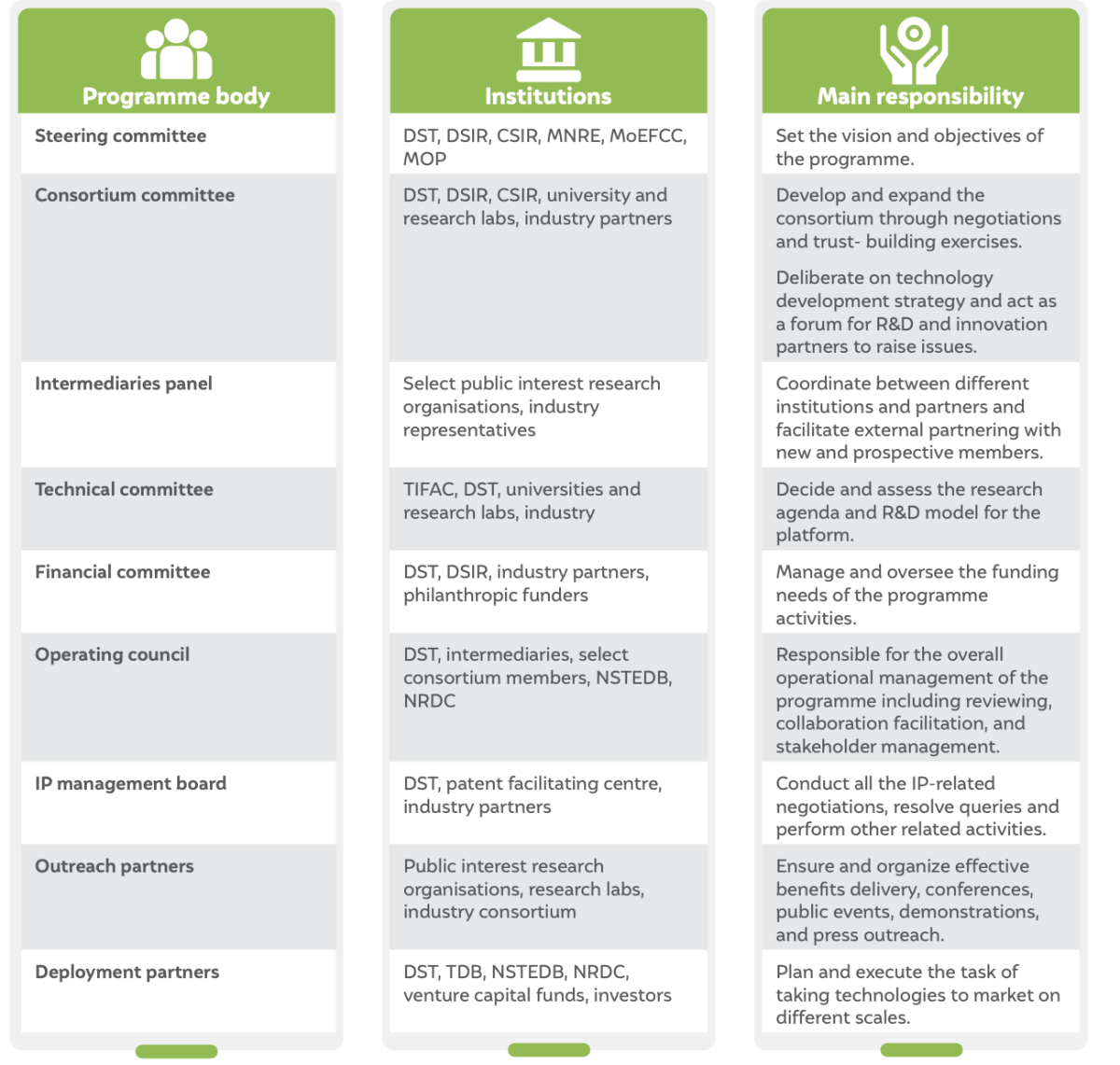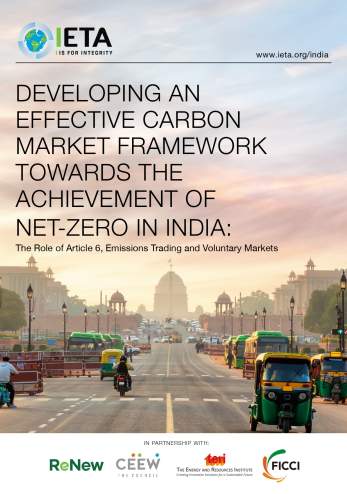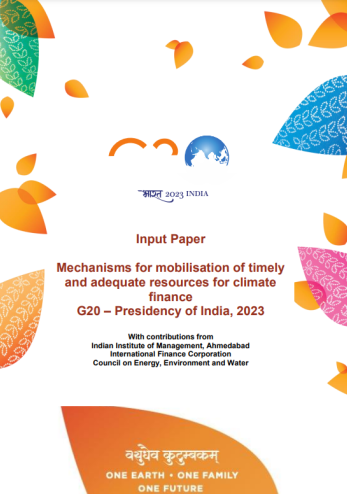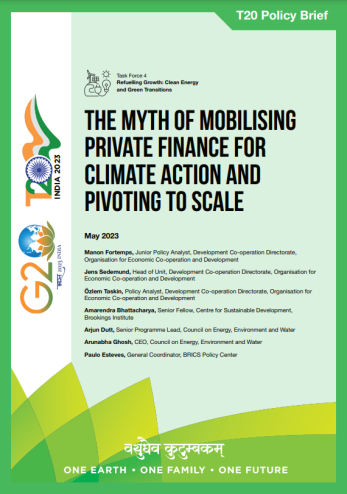



Suggested citation: Dixit, Himanshu, and Shikha Bhasin. 2021. Collaborative R&D for Sustainable Cooling in India: Institutional Reforms to Accelerate Technology Deployment. New Delhi: Council on Energy, Environment and Water.
This report highlights the need to tap into the expertise available across research institutions, universities, government agencies and industry to create a thriving ecosystem of collaborative R&D dedicated to cooling. It examines some of the key public–private R&D collaborations that have led to successful outcomes and determines the underlying factors of success. It analyses these factors in the form of the best practices that collaborative innovative programmes follow across areas such as policy vision, financing, intellectual property negotiations, intensity of collaboration and deployment strategies in order to increase chances of success and operational efficiency. Further, the study lays out a summary of these best practices and recommendations to operationalise them.
Also read: Cooling India with Less Warming
Proposed institutional structure to support public–private collaborative cooling R&D

 Source: Authors analysis
Source: Authors analysis
The question before us is simple: Can we cool India with less warming?
Only 8 per cent households currently own ACs in India (ICAP 2019). By 2037, the ownership is expected to increase five-fold to about 40 per cent of households (ICAP 2019). An expected USD 100 billion market for ACs (Indiaspend 2021)— and we haven’t even reached the half-way mark yet! Expansion of cold chains, refrigeration for perishables, healthcare and pharma products will become huge markets in themselves. Will it be possible to provide thermal comfort and cooling to population with just in-kind (vapour compression) technologies1 ? Clearly a tall order. On the climate side, can we afford to keep providing more and more energy for cooling? Absolutely not. The only way forward is to make investments in R&D for the development, diffusion and deployment of new and efficient technologies to increase access to sustainable cooling for all people, and across sectors. Here is an opportunity to tap into one of the biggest cooling markets in the world, while mitigating GHG emissions. Hence, to serve the exploding demand for cooling across sectors and for technologies in use, not only levels of inkind technologies have to be ramped up but also, new and upcoming technological alternatives need to be scaled up.
1 In-kind technologies refer to the technologies that are predominantly used for various applications in a sector. For instance, vapour compression is an in-kind technology as it remains the most popular option for cooling and heating purposes. For more discussion on typology of technologies, see Ghosh et al. (2019).
The Government of India has accorded due importance to cooling in its discussions on development and policymaking as thermal comfort and cooling remain central to human well-being and productivity. Cooling is widely used in residential housing and commercial buildings, for cold storage and refrigeration, in transportation, and in industries in India already, in terms of scale of utilisation as well as types of applications.
Given the low base of cooling access in India, in addition to commitments made within the Kigali Amendment to the Montreal Protocol as well as energy security and utilisation projections, novel technological solutions to cooling are needed. To meet this growing demand of cooling in future, a dedicated focus on innovation, increasing efforts on cooling R&D, and enhancing industrial competitiveness become highly essential. We need to actively accelerate the identification and deployment of alternatives to current refrigerants (with high global warming potential) in use, enhance energy utilisation and efficiencies, and provide affordable thermal comfort through new applications to the Indian population at large.
National policies such as the India Cooling Action Plan incorporate a renewed commitment to accelerate the pace of research and development (R&D) and innovation in the cooling sector so as to develop and deploy novel cooling technologies. Collaboration is the main thrust of India’s cooling research efforts. Expertise available across research institutions, universities, companies, government agencies, and private labs must be leveraged to create a thriving ecosystem of collaborative R&D dedicated to cooling.
To support the accomplishment of this goal, we aim to bridge critical gaps in research on the following questions for India’s cooling domain:
1. What are the institutional and operational tenets of success for collaborative R&D programmes in India?
2. What are the institutional mechanisms that currently exist for supporting R&D in cooling sectors?
3. How do we incorporate best practices into ongoing and upcoming collaborative R&D platforms dedicated to cooling?
In order to build evidence to answer the research questions, we undertook extensive desk research to collect information about the Indian government’s initiatives to support research and technology development in sustainable cooling. Collaborative innovation programmes and their details such as programme focus, outputs, etc. were also collected during desk research.
Semi-structured interviews with experts and consultative sessions with stakeholders were conducted to complement desk research. These interviews and sessions helped us gain insights into (a) the drivers of success and best practices followed by research programmes perceived to be successful and (b) the institutional challenges underpinning collaborative research in India.
By drawing comparisons and experiences from different cases, the institutional and operational practices critical to the success of a collaborative and multi-stakeholder research and technology development programme were identified.
Based on stakeholder interviews and desk research, we developed an analytical framework to compare case studies on key collaborative R&D initiatives in the cooling domain. The following best practices were identified as being critical to their success:
Our learnings show that for any institutional mechanism to spur a cooling-centric R&D and innovation platform, in addition to different kinds of support, attention has to be given to key operational aspects of the programme. Many of these best practices can be institutionalised as part of the platform itself to ensure success going forward. The institutional lessons or reforms as presented in the report can be applied to the existing national programmes for a successful collaboration between different actors in the cooling research ecosystem. These can be summarised as follows:

Source: Authors’ analysis
Based on the learnings from our analysis, we propose to support the new R&D initiatives through an elaborate institutional structure, with functions defined to reflect the most important aspects of the programme. This support framework brings together various institutions that have so far been working in silos. It envisages integration of various activities at different stages of research and technology development on one platform. The main aim of institutional integration is to bring together diverse expertise and experiences. The Department of Science and Industrial Research (DSIR) affiliated institutions have a better understanding of industry’s functioning while the Department of Science and Technology (DST) knows the university landscape intimately, for example. It proposes an intermediary panel as an interface structure between different institutions with the major task of liaising with the platform partners and facilitate better coordination. Independent public research organisations that have a strong interface with industry establishment and government bodies can be entrusted to perform the role of an intermediary as it is responsible for both stakeholder and research management. ES1 shows how different institutions can be grouped together to enable a much better thinking, planning, management and collaboration for cooling related R&D and technology development.
ES 1 Institutional groupings and their functions to enable future collaborative cooling R&D

 Source: Authors’ analysis
Source: Authors’ analysis
Technologies that involve the use of high-GWP refrigerants or components that are not energy efficient which lead to global warming and climate change have to be replaced with sustainable technologies. The technology profile of the cooling sector necessitates changes as the current technology in use is environmentally unsustainable, and their applications are limited. Hence, the transition to sustainable technologies and identification of relevant applications across sectors needs R&D, product development, and innovation. More importantly, it has to be underscored that the success of such endeavours would critically depend on how well different actors in cooling collaborate with each other.
Since India’s cooling sector requires a thriving R&D ecosystem, we engaged in a research to ascertain how this may be encouraged through the introduction of institutional reforms in existing innovation programmes dedicated to cooling. We started by examining some of the key public–private R&D collaborations that have led to successful outcomes and determined the underlying factors of success. These factors were then analysed in the form of the best practices that collaborative innovative programmes follow across many different areas such as policy vision, financing, intellectual property negotiations, intensity of collaboration and deployment strategies in order to increase chances of success, operational efficiency, etc. These institutional lessons were further contextualised and an initial set of recommendations were prepared for programmes in general. In other words, a summary of best practices and ways of operationalising them was offered by way of these recommendations.
Through the implementation of the best institutional practices in research programmes, we believe that the overall R&D and technology outcomes will become better. This will help us arrive at the goal of clean and sustainable technologies faster. These smaller goals are subservient to our larger goal to make the country a net-zero carbon emitter, which is indeed closely linked to reducing the carbon footprint of cooling applications. It is only going to be possible through the realisation of technology transitions in different end-use applications.
In terms of expanding the conversation around this topic, a fair bit of analysis is still required to be done to fix the incentive structure for different research actors to innovate in the country. There are more insights to be gained about how research in academia can be aligned and shaped in response to the industrial realities and priorities, not just in terms of a programme, but as engendering of a collaborative innovation ecosystem. In addition, a deeper investigation of the institutional mechanisms, and set-ups that support technology development in the country have to be undertaken to streamline the processes they follow. There may also be a need to assess the institutions for promotion of technology development in terms of upgrading their funding, capacity and outreach, and building new specific functions within them.
Going forward, questions related to cooling supply chains in India and the issues that import dependent supply chains pose to cooling R&D and adoption of new technologies will be examined. It will be a befitting complement to the attempts made by the Government of India to give a fillip to manufacturing in the white goods sector through a Production Linked Incentives (PLI) scheme. Further linkages between public research labs and industrial research will also be highlighted as part of the ongoing work on collaborative R&D.
As a final word, the success of the proposed recommendations will depend on the zeal and commitment with which they are implemented. Articulating the changes as the first step must be followed by a long process of canvassing with concerned authorities to discuss these changes and modulate them as per the specific context and identified opportunities and limitations.

Developing An Effective Carbon Market Framework Towards The Achievement Of Net-Zero In India

Mechanisms for Mobilisation of Timely and Adequate Resources for Climate Finance

The Myth of Mobilising Private Finance for Climate Action and Pivoting to Scale